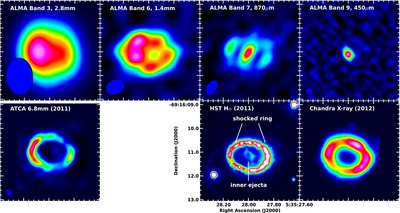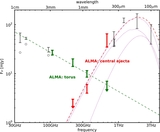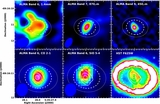Image Details

Caption: Figure 1.
Top row: continuum images of SN 1987A in ALMA Bands 3, 6, 7, and 9 (2.8 mm, 1.4 mm, 870 μm and 450 μm respectively). The spatial
resolution is marked by dark blue ovals. In Band 9 it is 0.33 × 0
![]() 25, 15% of the diameter of the equatorial ring. At Bands 7, 6, and 3 the beams are 0.69 × 0
25, 15% of the diameter of the equatorial ring. At Bands 7, 6, and 3 the beams are 0.69 × 0
![]() 42, 0.83 × 0
42, 0.83 × 0
![]() 61, and 1.56 × 1
61, and 1.56 × 1
![]() 12, respectively. At long wavelengths, the emission is a torus associated with the supernova shock wave; shorter wavelengths
are dominated by the inner supernova ejecta. The bottom row shows images of the continuum at 6.8 mm imaged with the Australia
Telescope Compact Array (ATCA; Zanardo et al. 2013, 0
12, respectively. At long wavelengths, the emission is a torus associated with the supernova shock wave; shorter wavelengths
are dominated by the inner supernova ejecta. The bottom row shows images of the continuum at 6.8 mm imaged with the Australia
Telescope Compact Array (ATCA; Zanardo et al. 2013, 0
![]() 25 beam), the hydrogen Hα line imaged with the
Hubble Space Telescope (
HST; Image courtesy of R. Kirshner and the SAINTS collaboration; see also Larsson et al. 2013), and the soft X-ray emission imaged
with the
Chandra X-Ray Observatory (Helder et al. 2013).
25 beam), the hydrogen Hα line imaged with the
Hubble Space Telescope (
HST; Image courtesy of R. Kirshner and the SAINTS collaboration; see also Larsson et al. 2013), and the soft X-ray emission imaged
with the
Chandra X-Ray Observatory (Helder et al. 2013).
Copyright and Terms & Conditions
© 2014. The American Astronomical Society. All rights reserved.






